From Russia With Love: Hammerfall
Hammerfall is a gorgeous work-in-progress 2D game out of Russia. This particular release was posted to the GameDev.ru forums by “GKosh” for feedback and is marked as version 0.2. It’s a little rough around the edges, but it’s a remarkable production and wholly playable as is. The physics are well-tuned, the art is fantastic, and there’s even a storyline with charmingly clumsy English translation to tie it all together.
Swing Stuff Around
The video does a good job of demonstrating the mechanic. Hammerfall’s gameplay is all about swinging around connected bodies. Your mouse directly controls the position of your ship; move it up and your ship flies up. Your weapon–usually a mace or sword–is attached to your ship via a hinge joint. It swings around on its own, but you soon learn to control it deliberately.
What’s great about Hammerfall is how well-balanced the physics feel. Swinging the mace around feels heavy, but not so heavy that it starts to lead you around instead. It’s very difficult to make physics feel responsive, but Hammerfall manages a decent job of it. The learning process is occasionally frustrating, but before too long pulling off an intentional attack is second nature.
Variety is the Spice of Life
Despite the low version number of this release, Hammerfall is far more than a prototype. But even if it were a prototype, it’d still be fun. The one-on-one arena fighting is fun in its own right. But there’s so much more to the game. The variety in the levels is fantastic. The first few levels alone range from one-on-one fights to defending a blimp against hordes of bees.
Too often you see physics games that never quite break out of prototype stage. They may have a neat play mechanic, but the developer hasn’t fully realized how that mechanic will interact with a variety of level types. Hammerfall completely succeeds at utilizing its control mechanic across a number of contexts and goals.
Well Worth the Download
I’m really excited about what a 1.0 Hammerfall release could look like. If development continues at the same level of quality they’ve already achieved this could easily become a canonical physics game. The level of production is fantastic, but there’s also a distinct sense of indie spirit, as if the game were developed simply for the love of it rather than to meet some specific market segment.
Download Hammerfall (10.1 MB)
Updated v0.21 version with fixed English translation. This release is limited to 60 minutes of play per save file. Keep an eye on this GameDev.ru thread for updates (Google translate link).
Related Posts:
- Hammerfight (Hammerfall) Now Available on Steam
- Hammerfall Officially Emerges as Hammerfight
- List of Physics Games
- Defense With Physics: Momentum Missile Mayhem
Ride, Brave Pegasus-Pony! Ride!
Coaster Rider is based on Pegasus, an actual roller coaster in Germany’s Europa-Park. It was created by yoyogames.com member Bl@ckSp@rk. It’s a great game and in concept it is comparable to Line Rider, but with a tangible goal.
Deceptively Simple
The goal of Coaster Rider is deceptively simple; all you have to do is draw a track to get the roller coaster from its starting position to a checkered flag somewhere on the map. The catch is that, on your way to this flag, you must collect a number of stars placed around the map. In the first couple of levels this is a fairly simple task; the intended path to the end is fairly cut out by the position of the stars, but by the third level, the game will begin to test your mettle, and it doesn’t get easier through the rest of the ten levels.
Energy In, Energy Out
Coaster Rider is predominantly a game about conservation of energy. In most levels the amount of potential energy you start with is all you have to work with. Because of this, you’ll find yourself constantly tweaking and redrawing sections of the track in order to conserve more energy so you can make it up the next hill. In some levels, however, there are speed boost power-ups which help by adding more energy to the system. It’s up to you how you utilize this energy.
Trial and Error
Tracks in Coaster Rider are not made up of pre-built pieces, but rather they are drawn in a fashion similar to Line Rider. Because of the open-ended nature of track design, there is a huge emphasis on trial and error. Most things you build will not work perfectly the first time, so you will spend a lot of time redesigning the track.
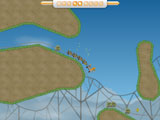
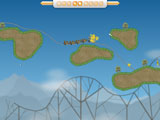
(Coaster Rider Game Screenshots)
Minor Complaints
Rather than the line drawing being completely fluid, it seems to be made up of small line segments, which can sometimes make drawing certain track layouts a pain, with sharper angles in comparison to smoother curves. It also would have been nice to have some sort of “undo” feature for when an “improvement” actually turns out to be detrimental to your track design. There is a save feature, however, which serves the game well enough.
Another minor way to improve the game would be a fast-forward function. Some of the levels’ tracks can become rather lengthy, and having to watch the entire ride over and over can become annoying when all you have to redesign is the very end of the track. Also sometimes the coaster will have just enough momentum to make it over a hill, which can take a long time as well, as you wait for it to slowly inch its way over the top and and down the other side. Being able to speed up the playback of the coaster would have helped with this.
A Fun Ride
Coaster Rider is a blast to play. You’ll most likely be hooked instantly, and it will probably take you a few days to beat, even with just 10 levels. It’s free and can be downloaded at:
Download Coaster Rider (12.2 MB)
Related Posts:
- 7 Children Die in Tragic Roller Coaster Accident
- Line Rider, America’s Favorite New Hobby
- Line Rider Coming to Consoles!
- News Roundup: Three Excellent Physics Toys
- List of Physics Games
Barrel of Fun? Or Barrel of Frustration?
Most physics-based puzzle games involve getting an object (it’s usually round) from point A to point B. The physics model – gravity, inertia, friction – handles most of the moving. Working out how to make the physics do what the player wants is the puzzle. Reaching that solution is a kind of experimentation. Look at the puzzle, imagine a possible solution. Patch it together using the tools the game provides. Press the “start” button, observe what happens. When something goes wrong, make modifications. Eventually, this process of observing and refining leads to the true solution.
Which brings me to CGS Software’s Barrel Mania.
Big Puzzles
The critical object in Barrel Mania is, of course, the barrel. Like most physics game lynchpins, it rolls, bounces, and falls. It’s blown up by a variety of hazards, from lava pits to mines. To make sure it isn’t destroyed on the way to its destination, the player is given a number of “gadgets”. These stick-like objects can be drawn anywhere at any angle, serving as platforms, ramps, and rails.
The player gets a bunch in each stage. The stages are enormous, usually several screens in length and width. The player is scored on how many pieces are left unused at the end, like in most physics puzzle games. However, the game’s secondary goal is to collect stars, which are scattered in difficult-to-reach nooks in each stage. To reach all of these stars, the player can’t be shy about using lots of gadgets. Barrel Mania encourages the player to build big.
It’s not a game of quick flashes of insight, but one of dedicated building and measured progress. Huge stages need to be mentally broken down and worked on one a piece at a time. The reward for a slow, dedicated effort is the sight of a vast, seemingly insurmountable landscape slowly transforming into a neat pathway of rails. The only way through is experimenting, observing the results, and refining a solution until it works.
Unlucky Breaks
What makes working out that solution difficult is a surprising amount of randomness in the game. I can run the same experiment twice and get two different results. On one try the barrel might get to the goal; on another, it might bounce into a pool of lava. One time the barrel might grab every star; the other time, it might miss one. It makes the game more exasperating than it needs to be. It’s hard to refine a solution based on the results of a test run if those results can’t be counted on. In a physics-based puzzle game, physics should be more important than luck.
There are also timing-based objects that exacerbate the problem. Some stages have lasers that fire periodically, sometimes missing the barrel, sometimes destroying it instantly. Worse are the spinning platforms, which might be in any position by the time the barrel reaches them. In the ten demo stages I played, I tried to avoid the spinners as much as possible by directing barrels around them. When contact was unavoidable, I built funnels that would compensate for a variety of possible outcomes. It feels sloppy and inefficient. What’s unfortunate is that the simple solution would have been to have all the objects in a stage reset to their starting positions each time the experiment is run.
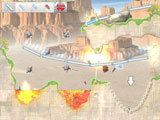
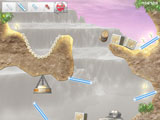
(Barrel Mania Game Screenshots)
How Many Barrels Do You Really Need?
Despite an identical premise to a number of games which came before it, Barrel Mania caters to players who want larger problems to wrestle with. For twenty dollars, though, it’s hard to overlook the jarring presence of luck in a game about controlled experimentation when there are so many other games about exactly the same thing.
Download Barrel Mania (24.9 MB)
Related Posts:
- List of Physics Games
- Trials 2SE Visual Upgrade, Same Great Physics
- Great-Looking Motorcycle Game, But Is It Fun?
- Interview: Peter Stock, Armadillo Run
- Interview with Matthew Wegner (Fun-Motion.com)


 (Rate this game! 918 votes, average: 4.16 out of 5)
(Rate this game! 918 votes, average: 4.16 out of 5)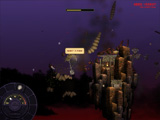


 My name is Matthew Wegner, and this site is dedicated to physics games.
My name is Matthew Wegner, and this site is dedicated to physics games.